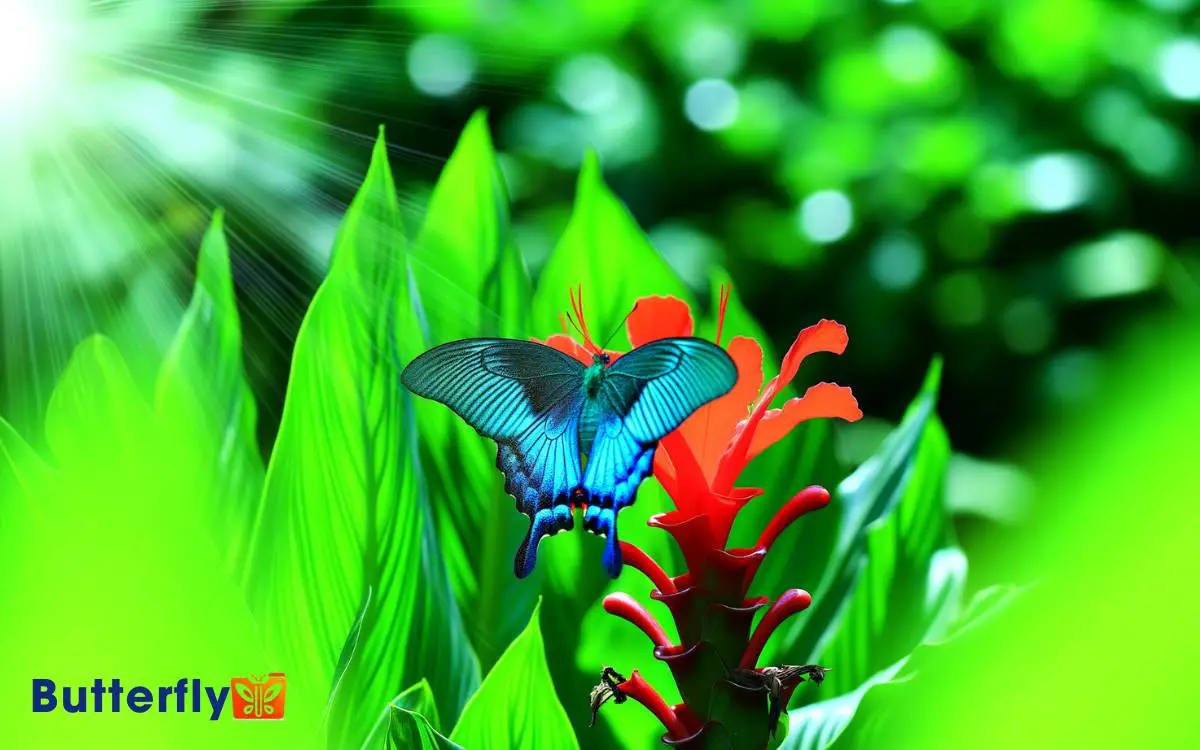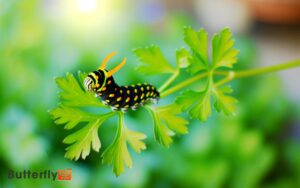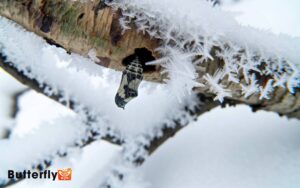Blue Mountain Swallowtail Butterfly Facts: Discover!
The Blue Mountain Swallowtail Butterfly (Papilio ulysses) belongs to the family Papilionidae. It showcases vivid iridescent blue wings, aiding in thermoregulation and predation avoidance.
Found in tropical rainforests of northeastern Australia, Papua New Guinea, and the Solomon Islands, it thrives up to 1,200 meters altitude.
Their lifecycle begins with eggs laid on Rutaceae plants, progressing through larval and pupal stages before emerging as adults. Known for selective nectar feeding and migratory behaviors, these butterflies play an essential role in pollination.
Habitat loss and climate change threaten their population, drawing attention to conservation needs. Discover the complexities of their survival and adaptation strategies.

Key Takeaways
Habitat
The Blue Mountain Swallowtail butterfly, scientifically known as Papilio ulysses, primarily inhabits the tropical rainforests of northeastern Australia, Papua New Guinea, and the Solomon Islands.
This species thrives in dense forest ecosystems, where the humidity and temperature create an ideal microclimate for its survival. They prefer altitudes ranging from sea level up to 1,200 meters.
Papilio ulysses displays a strong affinity for rainforest canopies and edges, which offer abundant flowering plants for nectar feeding and larval host plants.
Observations reveal that these butterflies are particularly attracted to native flora such as Euodia and Melicope species, which serve as important nectar sources and oviposition sites.
The presence of undisturbed forest is essential for their lifecycle and ecological balance.
Physical Characteristics
The Blue Mountain Swallowtail (Papilio ulysses) exhibits striking physical characteristics, with a wingspan ranging from 105-130 mm. Its iridescent blue wings, contrasted by black edges, are a defining feature within the Papilionidae family.
The butterfly’s size and unique wing shape contribute to its distinctive appearance and aerodynamic efficiency.
Wing Span and Color
Measuring a wingspan of about 10 to 14 centimeters, the Blue Mountain Swallowtail (Papilio ulysses) exhibits striking iridescent blue and black coloration that serves both as a warning to predators and a means of thermoregulation.
The upper side of the forewings features a vivid blue that reflects light, creating a shimmering effect, while the hindwings display a more subdued black. This iridescence is due to microscopic scales that diffract light, a characteristic common in the family Papilionidae.
The ventral side contrasts with muted brown and gray tones, aiding in camouflage when the butterfly is at rest. This dual functionality in coloration not only contributes to its survival but also makes it a fascinating subject for entomologists and nature enthusiasts alike.
Size and Shape
Sporting a robust, elongated body, the Blue Mountain Swallowtail exhibits a streamlined shape that aids its agility and speed in flight.
Scientifically named Papilio ulysses, this lepidopteran belongs to the family Papilionidae. Its wingspan ranges from 105 to 130 millimeters, making it a relatively sizeable butterfly.
The forewings are pointed and elongated, contributing to efficient aerodynamics, while the hindwings possess distinctive tails, characteristic of the Swallowtail genus. These tails not only enhance maneuverability but also serve as a defense mechanism, distracting predators.
The body is typically dark, with a blue metallic sheen on the dorsal side of the wings, which adds to its striking appearance. This morphology supports the Blue Mountain Swallowtail’s remarkable flight capabilities and survival in diverse habitats.
Life Cycle
Blue Mountain Swallowtail butterflies, classified scientifically as Papilio ulysses, undergo a fascinating life cycle marked by distinct stages of metamorphosis.
The cycle begins with the female butterfly laying eggs on host plants, typically belonging to the Rutaceae family.
These eggs hatch into larvae, commonly referred to as caterpillars. The caterpillars exhibit vibrant green coloration and feature specialized osmeterium to ward off predators.
After a period of feeding and growth, the larvae enter the pupal stage, forming a chrysalis. Inside the chrysalis, remarkable transformation occurs as the organism reorganizes into an adult butterfly.
Upon emergence, the adult Papilio ulysses showcases its iconic iridescent blue wings, ready to start its life of flight and reproduction.
Feeding Habits
The feeding habits of the Blue Mountain Swallowtail butterfly, Papilio ulysses, are intricately linked to its preference for nectar from a diverse array of flowering plants, particularly those within the Rutaceae family. This butterfly uses its long proboscis to extract nectar from blossoms, favoring bright-colored flowers that provide ample nourishment. Its selective feeding behavior helps pollinate various plant species, contributing to the health of its ecosystem. While it shares some similarities with other swallowtails, such as vibrant coloration, it differs in diet and habitat preferences from species that exhibit pipevine swallowtail unique traits.
These butterflies exhibit a remarkable affinity for plants such as Citrus and Murraya species, which provide ideal nectar resources.
Their proboscis, a specialized feeding organ, allows them to extract nectar efficiently, ensuring energy intake for flight and reproduction. Observational studies highlight their selective foraging behavior, often visiting blossoms during peak flowering periods.
This species’ dietary preferences not only sustain their metabolic needs but also facilitate pollination, contributing to ecosystem vitality. Papilio ulysses exemplifies the intricate interplay between lepidopteran feeding strategies and floral resource availability.
Mating Behavior
During the mating season, Papilio ulysses exhibits a series of intricate courtship behaviors that involve visual and chemical cues essential for successful reproduction. Males display their iridescent blue wings in sunlight to attract females, leveraging their unique morphology.
Pheromones play a vital role; males release specific chemical signals to entice potential mates.
Observations reveal a sequence of actions:
- Approach: The male approaches the female with deliberate, fluttering movements.
- Display: The male fans his wings to showcase their vibrant blue coloration.
- Pheromone Release: He releases pheromones to signal readiness and compatibility.
- Acceptance: The female indicates receptiveness through subtle wing vibrations.
These behaviors promote successful mating, securing the continuation of the species’ genetic lineage.
Predators and Threats
Despite its striking appearance, Papilio ulysses faces numerous predators and environmental threats that greatly impact its survival rates. Avian predators like birds often prey on these butterflies due to their vibrant blue coloration, which makes them conspicuous.
Additionally, parasitic wasps target their larvae, further reducing population numbers. Habitat destruction due to deforestation and urbanization poses a significant threat to their natural habitat, leading to a decline in available resources.
| Threat | Description | Impact on Papilio ulysses |
|---|---|---|
| Avian Predation | Birds are attracted to their conspicuous blue wings. | High mortality rates |
| Parasitic Wasps | Wasps lay eggs in larvae, causing developmental failure. | Reduced larval survival |
| Habitat Destruction | Deforestation and urbanization reduce their natural habitat and resources. | Population decline |
These threats necessitate conservation efforts to secure the species’ longevity.
Ecological Role
While facing numerous threats, Papilio ulysses plays an essential role in its ecosystem by serving as a pollinator for various flowering plants. This butterfly primarily visits blooms for nectar, thereby facilitating cross-pollination.
The Blue Mountain Swallowtail’s activities contribute to the genetic diversity and reproductive success of flora in its habitat.
Here are four key ecological contributions:
- Pollination: Secures the survival and propagation of diverse plant species.
- Biodiversity: Supports a wide range of flora, fostering a robust ecosystem.
- Food Source: Serves as prey for birds and other predators, maintaining trophic balance.
- Indicator Species: Reflects the health of its environment, signaling ecological changes.
Papilio ulysses holds a pivotal position within its ecological niche, promoting sustainability and biodiversity.
Migration Patterns
The migration patterns of Papilio ulysses, characterized by seasonal movements and habitat shifts, demonstrate a complex interplay between environmental cues and biological imperatives.
These butterflies, belonging to the family Papilionidae, exhibit migratory behavior primarily driven by temperature fluctuations and food availability.
Observations indicate that Papilio ulysses moves from lowland tropical forests to higher altitudes during warmer months, seeking cooler climates and abundant nectar sources.
Their remarkable navigational abilities suggest an innate response to photoperiod changes and habitat conditions. This periodic migration guarantees genetic diversity and ecological resilience.
Detailed studies on their migratory routes reveal a precise alignment with flowering cycles of native flora, underscoring the species’ adaptive strategies for survival and reproduction.
Conservation Status
Facing significant threats from habitat destruction and climate change, the conservation status of Papilio ulysses demands urgent attention and targeted conservation strategies.
This butterfly, belonging to the family Papilionidae, faces a declining population due to several anthropogenic factors.
- Habitat Loss: Deforestation and land conversion for agriculture are primary threats, reducing available larval host plants.
- Climate Change: Altered weather patterns affect breeding cycles and migration routes, impacting survival rates.
- Pesticides: The use of chemical pesticides in agriculture diminishes populations by contaminating their natural habitats.
- Illegal Trade: The butterfly’s striking appearance makes it a target for collectors, exacerbating population decline.
Effective conservation requires habitat protection, sustainable land-use practices, and stringent regulations to curb illegal trade.
Interesting Facts
Among its remarkable features, *Papilio ulysses* displays iridescent blue wings that serve as a stunning example of structural coloration in the Lepidoptera order.
This optical phenomenon arises from microscopic scales that refract light, creating a vibrant blue hue that captivates observers.
Native to Australia and Papua New Guinea, this butterfly’s wingspan can reach up to 14 cm, making it one of the larger members of the Papilionidae family.
Additionally, *Papilio ulysses* exhibits sexual dimorphism; males flaunt more vibrant blue wings compared to females, aiding in mate attraction. The larvae feed primarily on Euodia trees, while adults prefer nectar from Lantana and Hibiscus flowers.
The species’ remarkable adaptability ensures it flourishes in diverse habitats, from rainforests to suburban gardens.
Conclusion
In the grand tapestry of Lepidoptera, the Blue Mountain Swallowtail, *Papilio ulysses*, emerges as a vibrant brushstroke, enchanting with its iridescent wings and intricate life cycle.
Much like Darwin’s finches, this butterfly exemplifies nature’s adaptability and resilience. As it flutters through the rainforest, it not only perpetuates its species but also sustains the ecosystem’s balance.
Conservation efforts are essential to ensuring this jewel of the forest continues to fascinate and contribute to biodiversity.






